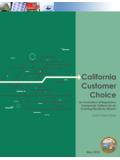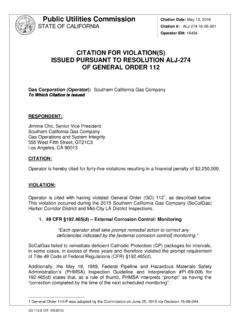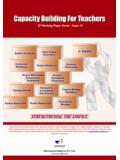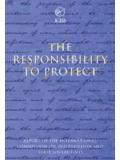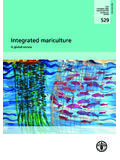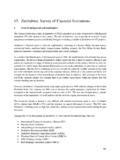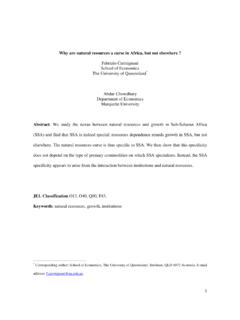Transcription of Southern California Edison’s 2018‐2020 General …
1 Risk and Safety Aspects of Southern California Edison's 2018 2020 General Rate case Application 16-09-001. Arthur O'Donnell Amy C. Baker Wendy Al-Mukdad Steve Haine, Chris Parkes Junaid A. Rahman January 31, 2017. This page intentionally left blank 1. EXECUTIVE SUMMARY. The California Public Utilities Commission is in the process of advancing a new risk- informed process to support decision-making in the context of energy utility General Rate Cases (GRCs). The major goal is to improve safety performance of utility design, construction, operations & maintenance (O&M) by applying a transparent and understandable set of utility processes to identify and prioritize significant safety risks, to determine appropriate mitigation programs and projects to reduce or avoid those risks, and to translate those priorities, programs and projects into the GRC budget requests.
2 The development of this process has been taking place via a 2013 rulemaking proceeding and subsequent applications for Safety Model Assessment Proceedings (S-MAP). 1 This rulemaking, via Decision (D.) 14-12-025 established new mechanisms for developing risk- informed methodologies, incorporating them in GRCs, and requiring new accountability reporting to ensure that the utilities are meeting expectations for approved funding authorizations for safety programs and risk mitigations. Even before the finalization of this new approach to ratemaking, however, California 's major investor-owned utilities are required to incorporate elements of evolving risk assessment models and risk-informed mitigation into triennial GRCs and other rate cases. The Risk Assessment and Safety Advisory Staff of the CPUC's Safety & Enforcement Division (SED) has the responsibility for supporting the S-MAP proceedings and for working with the Investor Owned Utilities (IOUs) to help implement appropriate policies and approaches to accomplish this.
3 As part of that responsibility, SED has prepared this report on Risk and Safety aspects of Southern California Edison's (SCE) General Rate case application for 2018 . 2020. The GRC Scoping Memo indicated that SED's report will help the Commission identify whether and how SCE is complying with the guidelines for risk management that were provided in and are currently being further developed in the S-MAP proceeding. 2. 1. Order Instituting Rulemaking to Develop a Risk-Based Decision-Making Framework to Evaluate Safety and Reliability Improvements and Revise the General Rate case Plan for Energy Utilities; R. 13-11-006. 2. Scoping Memo for SCE TY2018 GRC CPUC Application , December 12, 2016, pgs. 8-9: This report provides a description of risk and safety in SCE's GRC testimony and analyzes how SCE's current risk assessment and management process is evolving and SCE is using it to: identify major risks.
4 Determine potential mitigation plans and programs; and inform SCE's GRC budget requests in order to reduce or avoid those major risks. Because this is an evolving program, this report is more concerned with understanding SCE's approach, providing illustrative examples of major safety and risk issues in the utility's testimony and critiquing how well the utility has applied its methodology to the task of identifying, prioritizing and mitigating its operational safety risks. SED Staff is engaged in a parallel process in the S-MAP to apply a critical evaluation of the utilities' risk models and to provide guidance for greater consistency among them, as well as working through the practical logistics of making risk assessment a more effective tool for regulatory oversight of utility operations and Staff recognizes that in this Application, SCE employs new and evolving methods to assess risk.
5 Though far from an exhaustive analysis of every aspect of SCE's risk assessment and safety mitigation proposals, this report will attempt to describe in understandable terms how the utility has described its process to assess and prioritize its major risks, and recommend how this might be improved in future GRCs. In addition, Staff has compiled current data and statistics related to recent incidents reported by the utility, citations imposed by the Commission for violations of rules and General orders, and audits of operations conducted by CPUC enforcement staff. This represents a new element of GRC evaluation, as called for by recent It is still unclear whether this information will have direct relevance in the Commission's eventual decisions on utility rate requests, but much like the entire Risk Assessment program in its still nascent state it provides a platform for the Commission and the utility to build upon in future GRCs.
6 3. In , et al., SED Staff provided an analysis of the four major utilities' risk models, as presented in their May 2015 applications and refined via a series of workshops and working groups. The Commission continues with the development of modelling approaches in Phase 2 of the proceedings, still ongoing. 4. PU Code Section 750, added by statute 2014, Ch. 552, Sec. 2 (SB 900, Hill). OBSERVATIONS AND CONCLUSIONS. SED Staff analyzed and evaluated the risk-informed decision framework used by SCE to identify major risks and determine potential mitigation plans and programs, and concluded that these methods and processes have not been particularly well described or effectively used to inform the 2018 GRC Test Year budget request. SCE admitted in testimony that it did not use risk assessment in the identification of its top risks, or to select programs to address those risks, but mostly after-the-fact as a way to measure risk reduction associated with the programs or projects proposed.
7 Further, the funding allocation for risk mitigations was not based on risk analysis. These two admissions, by themselves, have made it very difficult for SED to provide a positive evaluation of risk assessment in this GRC application. At this time, it would be unwise to accept SCE's risk assessment methods as a basis for determining reasonableness of safety- related program requests; indeed, we have found that SCE is classifying major categories of spending as safety related, even though they relate to issues of customer satisfaction or electric service reliability than safety. Additionally, much more could be done in the future to assist decision makers and intervenors in following the trail from risk assessment to budget request. The current GRC, although partly subject to the new risk-informed decision-making approach, is essentially a transitional case .
8 The traditional tools of intervenor testimony, evidentiary hearings and cross-examination of witnesses must still provide the Commission with a complete record for its decisions in this rate case . Finally, as required by statute,5 SCE bears the burden of proof to affirmatively establish the reasonableness of all aspects of its requests. 5. PU Code Section 454. MAJOR FINDINGS ON SCE'S RISK METHODOLOGY AND APPLICATION. SCE's approach to risk-based decision-making is still evolving and most of the steps in the framework have yet to be implemented. In the current GRC, most of focus was on the first two steps of risk identification and risk evaluation. Currently, the majority of the risk analyses are conducted after a project or a program is identified, to measure the risk reduction associated with that project or program.
9 SCE's GRC testimony does not contain what can be properly referred to as a risk register. A risk register based on risk event statements should contain, at a minimum, asset or activities, failure event statements, frequencies, impact dimensions, impact dimension scores, and other relevant information. SCE's approach to identify threats or risk drivers suffers from an almost non-existent level of granularity. Based on the presentation in the testimony, it is unclear whether risks were used to drive mitigation activities, or, rather, mitigation activities were looking for risks to mitigate. SCE's risk-spend efficiency metric is not mature enough to drive the 2018 GRC request at a program or project level. SCE's current risk-informed decision-making process is still too immature in this GRC. cycle to allow meaningful analysis using the full Cycla 10-step process.
10 Staff struggled to evaluate SCE's risks and risk assessment process in the initial stages of review. As a result, staff asked SCE to compile all of its risk testimony into a single volume. Even after receiving this compiled testimony, SED staff was still unable to see the bigger picture of SCE's risk assessment story. There were many individual parts, but we still could not determine how they contributed to the larger GRC. For example, SCE. could not provide even a qualitative prioritization of its risks, and there were only two risk register items for which SCE used risk assessment to inform its current GRC request. SCE's definition of an outcome is what other utilities would typically define as a risk, and the outcome numbers in SCE's risk register show a very irregular distribution. The cause of this irregular distribution of outcomes appears to be due to the wide range of specificity levels in the risk definitions.
